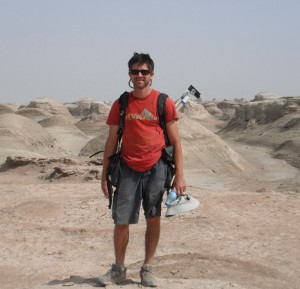 |
Climatic and tectonic controls on sedimentation and erosion within the Qaidam Basin, ChinaRichard Heermance Department of Geological Sciences Wednesday, March 26th, 2014 |
||
|
|||
|
The Qaidam Basin is an internally drained basin located in the NE corner of the Tibetan-Qinghai Plateau. Presently, over 50% of the basin floor is deformed by folding and faulting, and exposes thick (>1 km) sections of Plio-Quaternary strata. The nearly continuous Pliocene–Quaternary sedimentary record makes the Qaidam Basin an ideal locality to study the effects of global climate change during that time on local basin climate and basin evolution. We present new detailed stratigraphic, magnetostratigraphic, and stable isotope (δ18O, δ13C) data from the Pliocene Shizigou and Pleistocene Qigequan Formations along the southwestern flank of an intra-basin fold within the northwestern Qaidam Basin. Strata are characterized by shallow-lacustrine, marginal-lacustrine, and deltaic facies that contain meter-scale parasequences that we infer to be climatically controlled. Paleocurrents within the strata shift from eastward at the base toward southwest for the majority of the section, but abruptly shift toward the south in the upper 400 m. Twenty-two magnetozones constrain deposition between 5.2 Ma and ~0.8 Ma and reveal that sedimentation rates were fairly constant (474 ± 34 m/m.y.) from 5.2 to 3.0 Ma, after which time rates abruptly decrease to 154 ± 40 mm/yr before increasing again to ~750 m/m.y. since 1.2 Ma. The δ18O values shift from relatively constant (avg. -6.8, range -9.6 to -4.5 VPDB) values to less negative values (avg. -1.2, range -1.2 to -2.7 VPDB) between 3.1–2.6 Ma and to extremely variable values (avg. –2.9, range -8.3 to 4.0) after ~2.6 Ma. The post-2.6 Ma extreme variability in stable isotopes reflects the same time frame of enhanced cyclicity associated with Northern Hemisphere glaciation. The δ13C values remain relatively constant (average -4.0, range -5.7 to -1.0) until ~0.9 Ma, when the values increase to -0.3 (range -1.0 to 1.5) VPDB. The appearance of growth strata at 3.0 Ma, a sharp lithofacies change (Formation boundary) to shallow and sub-areal conditions by 2.6 Ma, and the observation of paleoyardangs (buried, wind-sculpted landforms) within lake-marginal strata at 2.4 Ma, imply that emergence of the adjacent anticline was followed by the shallowing or narrowing of the lake basin and sub-aerial exposure and erosion of marginal lake sediments. We interpret these data to reflect a significant change to a less humid, more arid climate in the Qaidam Basin between ~3.1 Ma and 2.6 Ma, overlapping with the onset of significant Northern Hemisphere glaciations. Lake-level cycles were on ~ 230,000 year frequency from 2.6 Ma-1.2 Ma, before increasing to ~12,000 year frequency suggesting increased aridity and broad, sub-areal exposure of lake sediments after the Plio-Quaternary transition. Tectonic inversion beginning at 3.0 Ma and enhanced aridification after 2.6 Ma provided an environment rich in friable material for wind deflation of the Qaidam Basin, a likely source for sediments on the Chinese Loess Plateau and nutrients for the Pacific Ocean carried by westerly winds. Depositional environments within the Qaidam Basin, however, lagged regional climate and tectonic changes by ~500,000 years, probably due to hydrologic budgets from the surrounding mountain ranges. Coeval basin inversion and increasing aridity throughout the Quaternary thus controlled both deposition and erosion within the region. |
|||

